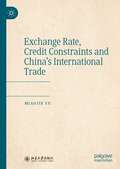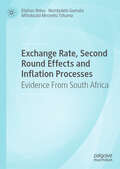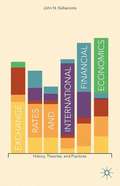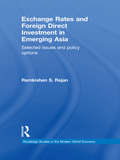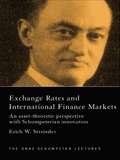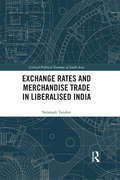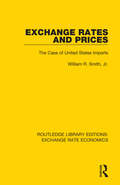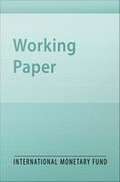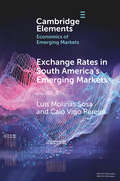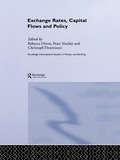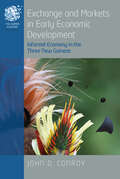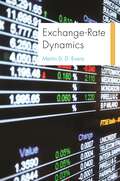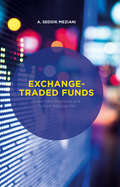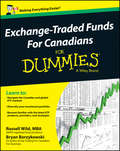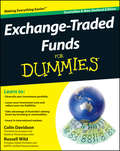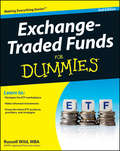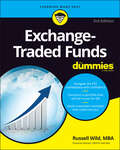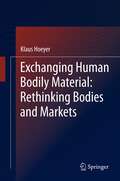- Table View
- List View
Exchange Rate Terminology and Analytics
by Robert E. KennedyAn introduction to the concept of exchange rates, simple analytics regarding currency appreciation and devaluation, and real and nominal exchange rates. Concludes with a series of examples that illustrate how shifts in exchange rates and inflation can affect firms' competitiveness.
Exchange Rate Volatility and World Trade
by International Monetary FundA report from the International Monetary Fund.
Exchange Rate, Credit Constraints and China’s International Trade
by Miaojie YuThis book, by one of China's leading economists, explores the past and present of the RMB—the people's currency—as it is poised to compete with the dollar as the international reserve currency. Exchange rate movement and its pass-through to changes in domestic prices have been topics of wide concern among economists. However, relatively few studies have empirically investigated the relationship between exchange rate movements and China's international trade.This book fills this gap, using the general equilibrium theory of the western economic science norm systems, integrating the leading heterogeneous firm theory of international trade, attempting to set up a theoretical structural model for further prediction, and applying the data from sample cases to examine the structural model. This book will be of interest to economists, financiers, and China watchers.
Exchange Rate, Second Round Effects and Inflation Processes: Evidence From South Africa
by Eliphas Ndou Nombulelo Gumata Mthokozisi Mncedisi TshumaThis book focuses on the exchange rate pass-through (ERPT), second round effects and the inflation process in South Africa. The authors demonstrate that magnitudes of the second round effects of the exchange rate depreciation and oil price shocks depend on inflation regimes. The impact of positive oil price shocks on inflation is weakened by monetary policy credibility. Evidence shows the influence of oil price on unit labour costs and correlation between exchange rate changes and inflation has weakened. In addition, ERPT is reduced by low business and consumer confidence, high trade openness, low inflation and high exchange rate volatility which weaken real economic activity. Both monetary and fiscal policy credibility lowers the sizes of ERPT to inflation and inflation expectations. Fiscal policy via fuel levies, administered prices and public transport inflation channel impacts the responses of monetary policy to inflation shocks. The authors show that second round effects contribute very little to wage inflation following an exchange rate depreciation shock. Both lending rate and household consumption responds asymmetrical to repo rate changes. This book will appeal to policymakers, students, academics and analysts.
Exchange Rates And International Financial Economics
by John N. KallianiotisThe recent financial crisis has troubled the US, Europe, and beyond, and is indicative of the integrated world in which we live. Today, transactions take place with the use of foreign currencies, and their values affect the nations' economies and their citizens' welfare. Exchange Rates and International Financial Economics provides readers with the historic, theoretical, and practical knowledge of these relative prices among currencies. While much of the previous work on the topic has been simply descriptive or theoretical, Kallianiotis gives a unique and intimate understanding of international exchange rates and their place in an increasingly globalized world.
Exchange Rates and Economic Fundamentals
by Peter B. Clark Steven A. Symansky Leonardo BartoliniA report from the International Monetary Fund.
Exchange Rates and Foreign Direct Investment in Emerging Asia: Selected Issues and Policy Options (Routledge Studies in the Modern World Economy)
by Ramkishen S RajanWith the rapid growth of China and India and the resurgence of Southeast Asia post-1997–8, emerging Asia has once again become one of the most dynamic regions in the world. This dynamism has in turn been fuelled largely by a carefully calibrated embracement of economic openness to international trade, investments and capital flows. While much has been written about international trade, there has been somewhat less work on the issue of capital flows, macroeconomic management and foreign direct investment (FDI) to and from the region, a gap that this book attempts to fill. The book is divided into two parts. The first part deals with selected issues pertaining to macroeconomic management in small and open economies, with particular focus on exchange rates. The second part of the book deals with the trends and determinants of FDI in emerging Asia, its importance as a source of finance, its impact on growth and development, and the nexus between FDI and foreign portfolio flows (FPI). Overall, the chapters in this book tackle important policy issues of contemporary relevance, but are informed by analytical frameworks, data and empirics. While each of the topic areas chosen in individual chapters is intentionally narrow, the book as a whole covers a number of areas and countries/regions within Asia (i.e. East, Southeast and South Asia). While the chapters have been written in a manner that can stand up to academic scrutiny, they are also meant to be accessible to policy makers, researchers and others who might be interested in FDI and related issues in Asia.
Exchange Rates and International Finance Markets: An Asset-Theoretic Perspective with Schumpeterian Perspective
by Erich StreisslerThis book poses the important question of whether exchange rates are ultimately tied down by economic fundamentals. In a unique approach the subject is analysed from an asset holder's perspective and Streissler takes the reader through an authoritative and wide-ranging study including:*Friedman's case for flexible exchange rates*interest parity and
Exchange Rates and Merchandise Trade in Liberalised India (Critical Political Economy of South Asia)
by Suranjali TandonThis book examines the linkages between exchange rates and India’s merchandise trade since the 1990s. It looks at India’s trade in the post-liberalisation period through its two main components: commodities and trading partners, and provides a bird’s eye view through aggregate analyses accompanied by a historical narrative of the evolution of trade and exchange rate dynamics. Presenting a comprehensive analysis of bilateral and product-specific trade, the book explores the impact of exchange rate on labour intensive sectors and charts out major development. It also offers compelling evidence to suggest that if some commodities are identified as integral to India’s export plans, then the impact of exchange rate must be weighed by the Reserve Bank of India (RBI) prior to a market intervention. This timely volume will be of interest to scholars and researchers of economics, business and finance, development studies, trade, business, and industry as well as practitioners, think-tanks, and policy makers.
Exchange Rates and Prices: The Case of United States Imports (Routledge Library Editions: Exchange Rate Economics)
by William R. SmithOriginally published in 1996. This study looks at the impact of exchange rate fluctuation on the pricing practices of foreign industries that import into the United States market. It presents several studies of the pass-through behaviour of over 100 disaggregated commodity groups with bi-lateral exchange rates. The book presents analysis of specific competitors and their individual pricing responses to exchange rate changes, adding significantly to pricing theory as well as being useful for marketers in predicting business responses.
Exchange Rates and Wages in an Integrated World
by Antonio Spilimbergo Prachi MishraA report from the International Monetary Fund.
Exchange Rates in South America's Emerging Markets (Elements in the Economics of Emerging Markets)
by Luis Molinas Sosa Caio Vigo PereiraSince Meese and Rogoff (1983) results showed that no model could outperform a random walk in predicting exchange rates. Many papers have tried to find a forecasting methodology that could beat the random walk, at least for certain forecasting periods. This Element compares the Purchasing Power Parity, the Uncovered Interest Rate, the Sticky Price, the Bayesian Model Averaging, and the Bayesian Vector Autoregression models to the random walk benchmark in forecasting exchange rates between most South American currencies and the US Dollar, and between the Paraguayan Guarani and the Brazilian Real and the Argentinian Peso. Forecasts are evaluated under the criteria of Root Mean Square Error, Direction of Change, and the Diebold-Mariano statistic. The results indicate that the two Bayesian models have greater forecasting power and that there is little evidence in favor of using the other three fundamentals models, except Purchasing Power Parity at longer forecasting horizons.
Exchange Rates, Capital Flows and Policy (Routledge International Studies in Money and Banking #Vol. 30)
by Peter Sinclair Rebecca Driver Christoph ThoenissenCombining thorough scholarship with illuminating real-world examples, this edited collection provides insights on the causes and consequences of movements in both exchange rates and external assets and has a strong focus on the policy implications of operating in an open economy, particularly the choice of exchange rate and monetary policy, exchange rate intervention and policies on capital mobility.
Exchange and Markets in Early Economic Development: Informal Economy in the Three New Guineas (The Human Economy #10)
by John D. ConroyThe idea of an informal economy emerged from, and is a critique of, the ideology of ‘economic development’. It originated from Keith Hart’s recognition of informal economic activity in 1960s Ghana. In the context of four colonialisms – German, British, Australian and Dutch – this book recounts Hart’s effort in 1972 to introduce the informal ‘sector’ into development planning in Papua New Guinea. This was problematic, because ‘the market’ was scarcely institutionalized, and traditional modes of exchange persisted stubbornly. Rather than conforming with post-colonial economic ideology, the subjected people pushed back against imposed bureaucracy to practice informal and hybrid modes of economic activity.
Exchange-Rate Dynamics (Princeton Series in International Economics)
by Martin D. EvansA comprehensive and in-depth look at exchange-rate dynamicsVariations in the foreign exchange market influence all aspects of the world economy, and understanding these dynamics is one of the great challenges of international economics. This book provides a new, comprehensive, and in-depth examination of the standard theories and latest research in exchange-rate economics. Covering a vast swath of theoretical and empirical work, the book explores established theories of exchange-rate determination using macroeconomic fundamentals, and presents unique microbased approaches that combine the insights of microstructure models with the macroeconomic forces driving currency trading.Macroeconomic models have long assumed that agents—households, firms, financial institutions, and central banks—all have the same information about the structure of the economy and therefore hold the same expectations and uncertainties regarding foreign currency returns. Microbased models, however, look at how heterogeneous information influences the trading decisions of agents and becomes embedded in exchange rates. Replicating key features of actual currency markets, these microbased models generate a rich array of empirical predictions concerning trading patterns and exchange-rate dynamics that are strongly supported by data. The models also show how changing macroeconomic conditions exert an influence on short-term exchange-rate dynamics via their impact on currency trading.Designed for graduate courses in international macroeconomics, international finance, and finance, and as a go-to reference for researchers in international economics, Exchange-Rate Dynamics guides readers through a range of literature on exchange-rate determination, offering fresh insights for further reading and research.Comprehensive and in-depth examination of the latest research in exchange-rate economicsOutlines theoretical and empirical research across the spectrum of modeling approachesPresents new results on the importance of currency trading in exchange-rate determinationProvides new perspectives on long-standing puzzles in exchange-rate economicsEnd-of-chapter questions cement key ideas
Exchange-Traded Funds
by A. Seddik MezianiWith Exchange Traded Fund (ETF) sponsors constantly making new types of ETFs available, there is now a variety of ETFs that provide investors with an opportunity to develop diversified investment portfolios. Their sophistication has also grown to include a breed of ETFs that do not passively track the performance of an underlying index. With this assortment of newer ETFs, and more on the way, market strategists are now capable of devising all-ETF portfolios based on a multitude of asset allocation schemes that respond to the need of their clients. This book provides a comprehensive overview of the changes brought about by ETFs. It describes and analyses recent changes alongside their impact on investment portfolios, and discusses the continuing success of index-based ETFs and the reasons underlying their long-lasting achievements. The book offers an objective discourse on the newly minted smart beta ETFs and some of the issues surrounding them, and provides an overview of how the increasingly widespread ETF-based portfolio hedging strategies are constructed and implemented. Paying particular attention to the importance of asset allocation and the essential role it plays in portfolio construction, this book explores the role played by ETFs in changing investors' attitudes toward home bias, covering both established and emerging frontier markets. The author leverages his extensive background to integrate best professional practices and academic rigor for an increased understanding of the ever-evolving world of ETFs.
Exchange-Traded Funds For Canadians For Dummies
by Russell Wild Bryan BorzykowskiThe fast and easy way for Canadians to understand and invest in ETFs Exchange-traded funds (ETFs) are an increasingly popular part of the investing landscape, being less volatile than individual stocks, cheaper than most mutual funds, and subject to minimal taxation. But how do you use this financial product to diversify your investments in today's ever-changing market? Exchange-Traded Funds For Canadians For Dummies shows you in plain English how to weigh your options and pick the ETF that's right for you. It tells Canadian investors everything you need to know about building a lean, mean portfolio and optimizing your profits. Plus, the book covers all of the newest ETF products, providers, and strategies, as well as Commodity ETFs, Style ETFs, Country ETFs, and Inverse ETFs. The only book on the market catering specifically to Canadian investors Perfect for investors who want to fill in the blanks in their portfolio, adding ETFs to stocks and other common investment products Gives Canadian investors the tools they need to make informed and profitable investments in ETFs that are right for their portfolios The book also includes straightforward answers to commonly asked questions about ETFs and advice on how to avoid mistakes that many investors--even experienced ones--make. It provides forecasts of the future for ETFs and personal spending and also provides a complete list of ETFs and Web resources to assist your investing. With Exchange-Traded Funds For Canadians For Dummies, you'll learn how to incorporate ETFs into your investment strategy to produce reliable growth.
Exchange-Traded Funds For Canadians For Dummies
by Russell Wild Bryan BorzykowskiThe fast and easy way for Canadians to understand and invest in ETFs Exchange-traded funds (ETFs) are an increasingly popular part of the investing landscape, being less volatile than individual stocks, cheaper than most mutual funds, and subject to minimal taxation. But how do you use this financial product to diversify your investments in today's ever-changing market? Exchange-Traded Funds For Canadians For Dummies shows you in plain English how to weigh your options and pick the ETF that's right for you. It tells Canadian investors everything you need to know about building a lean, mean portfolio and optimizing your profits. Plus, the book covers all of the newest ETF products, providers, and strategies, as well as Commodity ETFs, Style ETFs, Country ETFs, and Inverse ETFs. The only book on the market catering specifically to Canadian investors Perfect for investors who want to fill in the blanks in their portfolio, adding ETFs to stocks and other common investment products Gives Canadian investors the tools they need to make informed and profitable investments in ETFs that are right for their portfolios The book also includes straightforward answers to commonly asked questions about ETFs and advice on how to avoid mistakes that many investors--even experienced ones--make. It provides forecasts of the future for ETFs and personal spending and also provides a complete list of ETFs and Web resources to assist your investing. With Exchange-Traded Funds For Canadians For Dummies, you'll learn how to incorporate ETFs into your investment strategy to produce reliable growth.
Exchange-Traded Funds For Dummies
by Russell Wild Colin DavidsonDiversify your investments with today's fastest growing financial product Exchange-traded funds (ETFs) offer access to a range of investments in a single trade, are usually less volatile than individual stocks, cheaper than most managed funds and more tax-effective. But how do you pick the one that's right for you? This straightforward book helps you weigh up your options, build an effective portfolio and maximise your profits. Get to know the major players in Australia and New Zealand — find a broker, open an account and familiarise yourself with suppliers and indices Understand risk control and diversification — learn the importance of a diversified, lowly correlated portfolio, and how ETFs can help you achieve this Invest smartly in commodities and precious metals — tap into the returns offered by the Australian mining boom Manage small-cap, large-cap, sector and international investments — take advantage of returns in local markets and invest directly in US-listed ETFs Add bonds, REITs and other ETFs — secure consistent yields and add property to your investment portfolio Work non-ETFs into your investment mix — improve returns through careful selection of active managed funds Fund your retirement years — determine how much you need for retirement, and how ETFs can get you there Open the book and find: Advice on choosing ETFs over options, CFDs and warrants Sample portfolios Tips on revamping your portfolio based on life changes How to avoid mistakes that even experienced investors make Forecasts for the future of ETFs in Australia and New Zealand A complete listing of Australian and New Zealand ETFs Great online resources to help you invest in ETFs Learn to: Diversify your investment portfolio Lower your investment costs and reduce your tax liabilities Take advantage of Australia's mining boom by investing in commodities Invest in international markets
Exchange-Traded Funds For Dummies
by Russell WildThe fast and easy way to get a handle on ETFsExchange-traded funds (ETFs) have a strong foothold in the marketplace, because they are less volatile than individual stocks, cheaper than most mutual funds, and subject to minimal taxation. But how do you use thisfinancial product to diversify your investments in today's fast-growing and ever-changing market?Exchange-Traded Funds For Dummies shows you in plain English how to weigh your options and pick the exchange-traded fund that's right for you. It tells you everything you need to know about building a lean, mean portfolio and optimizing your profits. Plus, this updated edition covers all of the newest ETF products, providers, and strategies, as well as Commodity ETFs, Style ETFs, Country ETFs, and Inverse ETFs.Create the stock (equity) side of your portfolioHandle risk control, diversification, and modern portfolio theoryManage small, large, sector, and international investmentsAdd bonds, REITs, and other ETFsInvest smartly in precious metalsWork non-ETFs into your investment mixRevamp your portfolio to fit life changesFund your retirement yearsPlus, you'll get answers to commonly asked questions about ETFs and advice on how to avoid mistakes that many investors--even the experienced ones--make. It provides forecasts of the future for ETFs and personal spending and also provides a complete list of ETFs and Web resources to assist your investment. With Exchange-Traded Funds For Dummies, you'll soon discover what makes ETFs the hottest investment on the market.
Exchange-Traded Funds For Dummies
by Russell WildBecome an ETF expert with this up-to-date investment guide Want to expand your portfolio beyond stocks and mutual funds? (Of course you do, you smart investor you.) Then take a look at exchange-traded funds (ETFs)! A cross between an index fund and a stock, they're transparent, easy to trade, and tax-efficient. They're also enticing because they consist of a bundle of assets (such as an index, sector, or commodity), so diversifying your portfolio is easy. You might have even seen them offered in your 401(k) or 529 college plan. Exchange-Traded Funds For Dummies is your primer on ETFs. It gives you an insider (the legal kind!) perspective on the investment process, starting with an overview of ETFs and how they differ from stocks and mutual funds. The book also helps you measure risk and add on to your portfolio, and offers advice on how to avoid the mistakes even professionals sometimes make. Throughout, you'll also find plenty of tips, tricks, and even sample portfolios to set you up on the right path for investment success. With Exchange-Traded Funds For Dummies, you will: Find out exactly what exchange-traded funds are and why they make good investments Mix and match stock portfolios to diversify yours Go beyond stocks for maximum diversification: bonds, real estate, and commodity ETFs Maintain your portfolio for future growth With the tricks of the trade in Exchange-Traded Funds For Dummies, you can easily apply the knowledge you gain to turn good investments into great ones. Happy earning!
Exchange-Traded Funds at Vanguard (A)
by Robert C. Pozen Steven VickersVanguard Group management, led by CEO John Brennan, was considering whether to launch exchange-traded funds (ETFs) in early 2000. ETFs, first created in the early 1990s, combined aspects of traditional mutual funds and closed-end funds. The US ETF industry had reached $36 billion in assets under management, growing rapidly over the past few years. Because ETFs were exclusively index-tracking products, Vanguard, the largest index mutual fund company, had some potential expertise in managing ETFs. However, entering this market would present also unique challenges for Vanguard. Vanguard had a philosophy espousing low-turnover investing, while ETFs enabled short-term trading. The company would also need to develop a distribution network for ETFs. Finally, since Vanguard's mutual fund investors owned the company, management considered whether existing shareholders would benefit from an ETF product launch.
Exchange: A Promise Is a Promise--Understanding the Connections Between Marketing and Political Exchanges
by John A. Quelch Katherine A. JoczIn modern Western societies, marketplace exchanges and political exchanges, and the pursuit of self-interest and the pursuit of the common good, are inextricably linked. People can use political exchanges - such as supporting politicians who favor antitrust enforcement - to address problems they experience in marketing exchanges. It works both ways, too - boycotting producers and subscribing to political publications are ways to leverage marketing exchanges to achieve social or political goals.
Exchanging Human Bodily Material: Rethinking Bodies and Markets
by Klaus HoeyerThis book addresses the debate usually tagged as being about 'markets in human body parts' which is antagonistically divided into pro-market and anti-market positions. The author provides a set of propositions about how to approach this and shows a way out of the concrete impasse of it. Assumptions about markets and bodies that characterize this debate are analyzed and described while the author argues that these assumptions are in fact constitutive for exchanges of human bodily material - but in unacknowledged ways. It is concluded that what we need is a different analytical approach to better understand the mechanisms at play when organizations exchange organs, tissues and cells for use in transplantation and fertility medicine.

